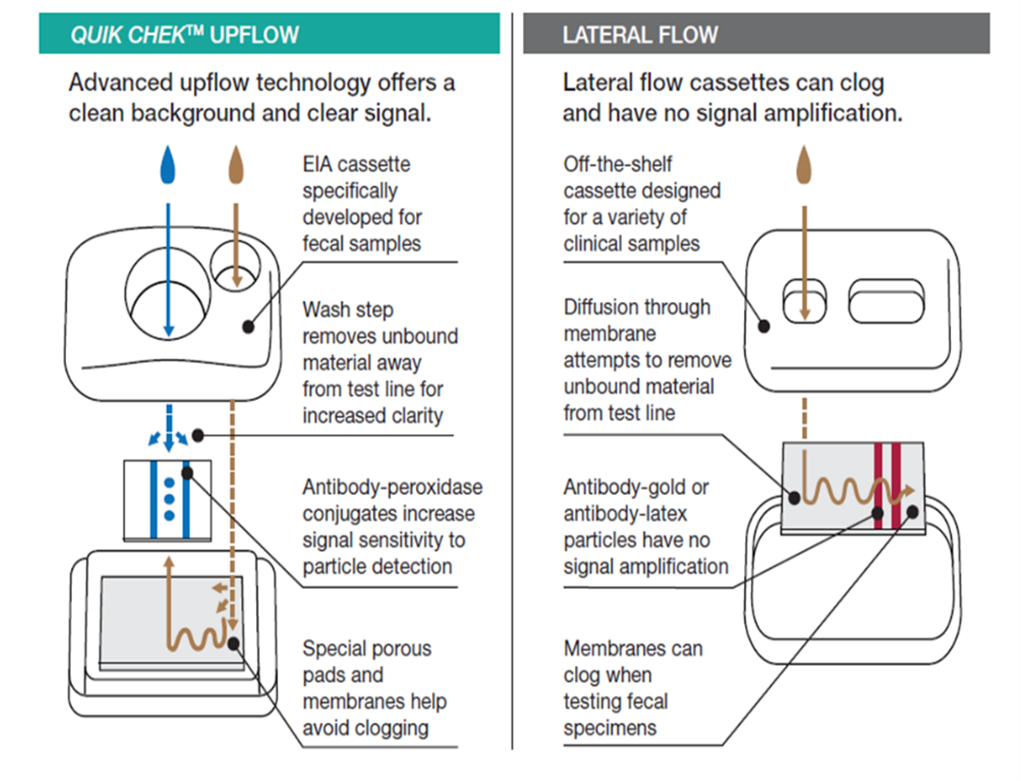The TECHLAB® QUIK CHEK™ Device Upflow Technology
The QUIK CHEK™ device upflow technology is designed to address the unique challenges of fecal samples, unlike lateral flow devices which are manufactured from off-the-shelf components intended for testing a variety of sample types.
These advantages can mean the difference between treatment which is correct and timely and one that is improper and delayed.
C. difficile, the most common hospital-acquired pathogen, is recurrent in 1:3 infected patients.1
Antibiotic resistant Campylobacter is classified as a high priority by the WHO3 and a serious threat by CDC.4
Shiga toxin-producing E. coli are responsible for >1 million illnesses globally each year.2
Advantages of the QUIK CHEK™ device upflow technology vs lateral flow

Filters the sample
The QUIK CHEK™ device upflow technology utilizes porous pads and porous membranes to filter the insoluble material typically present in fecal samples to avoid clogging. Lateral flow devices rely on uniform sample flow for proper test performance, and the membranes can clog easily, resulting in inconsistent sample flow and test failure.
Washes the membrane
The QUIK CHEK™ device upflow technology also includes a wash step to remove any unbound material away from the test line, increasing clarity and reducing background noise.
Amplifies the signal
Finally, the QUIK CHEK™ device upflow technology uses antibody-peroxidase conjugates to enzymatically amplify the signal strength, for quick and confident interpretation of results. In lateral flow devices, antibody particles, either gold or latex, offer no possibility for enzymatic signal amplification.
Accuracy matters. A patient’s health may depend on it. Even with complex fecal samples, the clean background and clear signal of the QUIK CHEK™ device upflow technology provide fast, reliable results.
References
1. Finn, E., Andersson, F.L. & Madin-Warburton, M. Burden of Clostridioides difficile infection (CDI) – a systematic review of the epidemiology of primary and recurrent CDI. BMC Infect Dis 21, 456 (2021). doi: https://doi.org/10.1186/s12879-021-06147-y
2. Food and Agriculture Organization of the United Nations (FAO) and World Health Organization (WHO.) 2019. Attributing illness caused by Shiga toxin-producing Escherichia coli (STEC) to specific foods. Microbiological Risk Assessment Series no. 32. Rome. doi: https://doi.org/10.4060/ca5758en
3. World Health Organization: Prioritization of Pathogens to Guide Discovery, Research and Development of New Antibiotics for Drug-Resistant Bacterial Infections, Including Tuberculosis, 2017. Geneva, Switzerland: World Health Organization; Available at: https://www.who.int/publications/i/item/WHO-EMP-IAU-2017.12
4. Centers for Disease Control and Prevention: Antibiotic Resistance Threats in the United States, 2019. Atlanta, GA: Centers for Disease Control and Prevention; Available at: https://www.cdc.gov/drugresistance/pdf/threatsreport/2019-ar-threats-report-508.pdf

